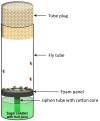Involvement of Inwardly Rectifying Potassium (Kir) Channels in the Toxicity of Flonicamid to Drosophila melanogaster
- PMID: 39859650
- PMCID: PMC11766345
- DOI: 10.3390/insects16010069
Involvement of Inwardly Rectifying Potassium (Kir) Channels in the Toxicity of Flonicamid to Drosophila melanogaster
Abstract
Inwardly rectifying potassium (Kir) channels regulate essential physiological processes in insects and have been identified as potential targets for developing new insecticides. Flonicamid has been reported to inhibit Kir channels, disrupting the functions of salivary glands and renal tubules. However, the precise molecular target of flonicamid remains debated. It is unclear whether flonicamid directly targets Kir channels or acts on other sites involved in the activation of transient receptor potential vanilloid (TRPV) channels. In this study, we observed that flonicamid is more toxic to flies than its metabolite, flumetnicam. This higher toxicity is difficult to reconcile if nicotinamidase is the active target, as flonicamid does not inhibit nicotinamidase. An alternative explanation is that flonicamid and flumetnicam may have distinct targets or act on multiple targets. Furthermore, reducing the expression of three individual Kir genes in the salivary glands of D. melanogaster significantly decreased the flies' susceptibility to both flonicamid and flumetnicam. The double knockdown of Kir1 with Kir3 or Kir2 with Kir3 further reduced the flies' sensitivity to both compounds. These findings confirm the involvement of Kir channels in mediating the toxic effects of flonicamid on flies. Overall, this study offers new insights into the physiological roles of insect Kir channels and flonicamid toxicity.
Keywords: flonicamid; flumetnicam; inwardly rectifying potassium channels; molecular target.
Conflict of interest statement
The authors declare no conflicts of interest. The founding sponsors had no role in the design of the study, the collection, analysis, or interpretation of data, in the writing of the manuscript or in the decision to publish the results.
Figures








Similar articles
-
Molecular Insights into Pharmacological Mechanism of Insect Kir Channels and the Toxicity of Kir Inhibitors on Hemipteran Insects.J Agric Food Chem. 2025 Mar 19;73(11):6522-6536. doi: 10.1021/acs.jafc.4c12183. Epub 2025 Mar 10. J Agric Food Chem. 2025. PMID: 40062477
-
Block of Kir channels by flonicamid disrupts salivary and renal excretion of insect pests.Insect Biochem Mol Biol. 2018 Aug;99:17-26. doi: 10.1016/j.ibmb.2018.05.007. Epub 2018 May 26. Insect Biochem Mol Biol. 2018. PMID: 29842935
-
Flonicamid and knockdown of inward rectifier potassium channel gene CsKir2B adversely affect the feeding and development of Chilo suppressalis.Pest Manag Sci. 2021 Apr;77(4):2045-2053. doi: 10.1002/ps.6232. Epub 2021 Jan 12. Pest Manag Sci. 2021. PMID: 33342029
-
Cholesterol Binding Sites in Inwardly Rectifying Potassium Channels.Adv Exp Med Biol. 2019;1135:119-138. doi: 10.1007/978-3-030-14265-0_7. Adv Exp Med Biol. 2019. PMID: 31098814 Review.
-
Inwardly rectifying potassium channels: their structure, function, and physiological roles.Physiol Rev. 2010 Jan;90(1):291-366. doi: 10.1152/physrev.00021.2009. Physiol Rev. 2010. PMID: 20086079 Review.
References
-
- Morita M., Yoneda T., Akiyoshi N. Research and development of a novel insecticide, flonicamid. J. Pestic. Sci. 2014;39:179–180. doi: 10.1584/jpestics.J14-05. - DOI
-
- Cho S.-R., Koo H.-N., Yoon C., Kim G.-H. Sublethal effects of flonicamid and thiamethoxam on green peach aphid, Myzus persicae and feeding behavior analysis. J. Korean Soc. Appl. Biol. Chem. 2011;54:889–898. doi: 10.1007/BF03253177. - DOI
-
- Koo H.-N., Lee S.-W., Yun S.-H., Kim H.K., Kim G.-H. Feeding response of the cotton aphid, Aphis gossypii, to sublethal rates of flonicamid and imidacloprid. Entomol. Exp. Appl. 2015;154:110–119. doi: 10.1111/eea.12260. - DOI
Grants and funding
LinkOut - more resources
Full Text Sources
Molecular Biology Databases

